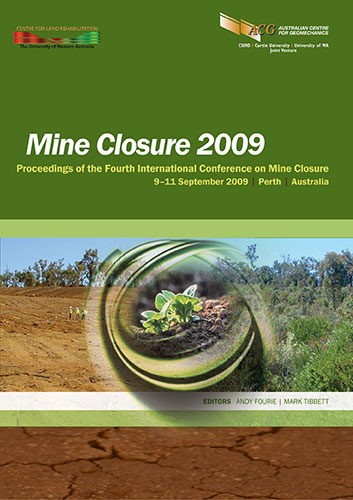Development of a metallophyte spatial database covering Australia

|
Authors: Pudmenzky, A; Rossato, L; Doley, D; Ramirez, C; Baker, AJM |
DOI https://doi.org/10.36487/ACG_repo/908_23
Cite As:
Pudmenzky, A, Rossato, L, Doley, D, Ramirez, C & Baker, AJM 2009, 'Development of a metallophyte spatial database covering Australia', in AB Fourie & M Tibbett (eds), Mine Closure 2009: Proceedings of the Fourth International Conference on Mine Closure, Australian Centre for Geomechanics, Perth, pp. 311-315, https://doi.org/10.36487/ACG_repo/908_23
Abstract:
Australia is characterised by a high endemic plant diversity and the presence of large areas of serpentine soils naturally rich in heavy metals, which are characteristically occupied by metal-tolerant plants, i.e. metallophytes. Metallophytes are ideal for decontamination and restoration of metal-contaminated sites. Unfortunately, many metallophyte species are under threat of extinction from mining activities in the underlying metal-rich substrates, and urgent action is required to conserve them before they are eliminated. A centralised metallophyte database covering Australia has been initiated to manage information on metal- tolerant native plant species, habitat and substrate characteristics. The database has also been linked to Phoenix, a 3D-GIS program which allows the user to view the results of spatial database queries superimposed onto an aerial photograph of Australia, and to extract information such as metal concentrations in substrata and plant parts. Since access to the database follows the Convention on International Trade in Endangered Species of Wild Fauna and Flora (CITES) guidelines in not allowing the exact location of rare or endangered species to be revealed, users who require this information will first need to acquire the relevant Australian regulatory authorisations. Interrogation of the metallophyte database constructed so far established that work in this field in Australia has largely prioritised the identification of native metal accumulators and hyperaccumulators (14 in Australia), and that far less attention has been paid to the identification of other metal-tolerant, but non- accumulating plants, i.e. excluders. However, it is these latter species that will be critical to the success and safety of rehabilitating metal tailings facilities. Australia is highly biodiverse, with 25,000 native species. It is therefore very likely that many more metallophytes from the Australian flora remain to be discovered. Improving and expanding this centralised database is crucial and constitutes one of the research priorities for the conservation of the unique Australian metallophyte biodiversity and mine rehabilitation. The database will assist mining companies in planning operations so as to avoid disturbance of vulnerable and valuable metallophyte biodiversity, as well as support decision-making for remediation and restoration exercises.
References:
Augee, M. and Fox, M. (2000) Biology of Australia and New Zealand, Benjamin Cummings, Australia.
Baker, A.J.M. (1981) Accumulators and excluders – strategies in the response of plants to heavy metals. Journal of
Plant Nutrition Vol. 3, pp. 643–654.
Baker, A.J.M. and Whiting, S.N. (2008) Metallophytes – A unique biodiversity and biotechnological resource in the
care of the minerals industry, In Proceedings of the Third International Seminar on Mine Closure, Mine Closure
2008, A.B. Fourie, M. Tibbett, I.M. Weiersbye, P. Dye (eds), 14–17 October 2008, Johannesburg, South Africa,
Australian Centre for Geomechanics, Perth, pp. 13–20.
Bradshaw, A.D. and Chadwick, M.J. (1980) The restoration of land. Blackwell Scientific Publications, Oxford.
Codd, E.F. (1970) A relational model of data for large shared data banks. Communications of the ACM, Vol. 13(6),
pp. 377–387.
Elmasri, R. and Navathe, S.B. (2006) Fundamentals of database systems, Fifth Edition, Pearson, USA.
Garmany, J., Walker, J. and Clark, T. (2005) Logical database design principles, Auerbach Publication, USA, 180 p.
Myers, N., Mittermeier, R.A., Mittermeier, C.G., da Fonseca, G.A.B. and Kent, J. (2000) Biodiversity hotspots for
conservation priorities, Nature, Vol. 403, pp. 853–858.
Pudmenzky, A., Rossato, L., McIlveen, G. and Mulligan, D. (2006) Phoenix: A Mine Environment Data Visualisation
and Management System, In Proceedings of the First International Seminar on Mine Closure, Mine Closure
2006, A.B. Fourie, M. Tibbett (eds), 13–15 September 2006, Australian Centre for Geomechanics, Perth,
Australia, pp. 773–779.
Whiting, S.N., Reeves, R.D., Richards, D., Johnson, M.S., Cooke, J.A., Malaisse, F., Paton, A., Smith, J.A.C., Angle,
J.S., Chaney, R.L., Ginocchio, R., Jaffré, T., Johns, R., McIntyre, T., Purvis, O.W., Salt, D.E., Schat, H., Zhao,
F.J. and Baker, A.J.M. (2004) Research priorities for conservation of metallophytes and their potential for
restoration and site remediation, Restoration Ecology, Vol. 12, pp. 106–116.
Williams, P.H., Humphries, C.J. and Gaston, K.J. (1994) Centre of seed-plant diversity: the family way, Proceedings of
the Royal Society of London, Biological Sciences, Vol. 256, pp. 67–70.
© Copyright 2025, Australian Centre for Geomechanics (ACG), The University of Western Australia. All rights reserved.
View copyright/legal information
Please direct any queries or error reports to repository-acg@uwa.edu.au
View copyright/legal information
Please direct any queries or error reports to repository-acg@uwa.edu.au